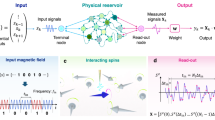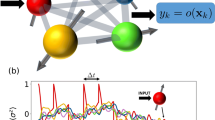Abstract
This paper reports and discusses the processing response dependence on a spin-wave reservoir chip, a natural computing device, to present one of the important steps to design a spin-wave reservoir computing hardware. As an example, we deal with a sinusoidal-square wave distinction task, where signals with a certain duration switch to each other at random. Observation of the transient response provides us with information useful for determining chip size and other parameters. Accumulation of this type of investigations will elucidate how we should design a spin-wave reservoir chip.
A. Hirose—This work was supported in part by the New Energy and Industrial Technology Development Organization (NEDO) under Project JPNP16007, and in part by Tohoku University RIEC Cooperative Research Project.
Access this chapter
Tax calculation will be finalised at checkout
Purchases are for personal use only
Similar content being viewed by others
References
Bueno, J., et al.: Reinforcement learning in a large-scale photonic recurrent neural network. Optica 5(6), 756–760 (2018)
Fernando, C., Sojakka, S.: Pattern recognition in a bucket. In: Banzhaf, W., Ziegler, J., Christaller, T., Dittrich, P., Kim, J.T. (eds.) ECAL 2003. LNCS (LNAI), vol. 2801, pp. 588–597. Springer, Heidelberg (2003). https://doi.org/10.1007/978-3-540-39432-7_63
Hirose, A.: Physical reservoir computing and complex-valued neural networks. In: International Conference on Neuromorphic Systems. Oak Ridge National Laboratory, Oak Ridge (online) (July 2020)
Hirose, A., Nakane, R., Tanaka, G.: Keynote speech: Information processing hardware, physical reservoir computing and complex-valued neural networks. In: Kimura, M. (ed.) IEEE International Meeting for Future of Electron Devices, Kansai 2019 (IMFEDK) Kyoto, pp. 19–24 (November 2019)
Hirose, A., et al.: Physical reservoir computing: possibility to resolve the inconsistency between neuro-AI principles and its hardware. Aust. J. Intell. Inf. Process. Syst. (AJIIPS) 16(4), 49–54 (2019)
Hirose, A., et al.: Proposal of carrier-wave reservoir computing. In: Cheng, L., Leung, A.C.S., Ozawa, S. (eds.) ICONIP 2018. LNCS, vol. 11301, pp. 616–624. Springer, Cham (2018). https://doi.org/10.1007/978-3-030-04167-0_56
Ichimura, T., Nakane, R., Tanaka, G., Hirose, A.: Spatial distribution of information effective for logic function learning in spin-wave reservoir computing chip utilizing spatiotemporal physical dynamics. In: 2020 International Joint Conference on Neural Networks (IJCNN), pp. 1–8 (2020). https://doi.org/10.1109/IJCNN48605.2020.9207629
Ichimura, T., Nakane, R., Tanaka, G., Hirose, A.: A numerical exploration of signal detector arrangement in a spin-wave reservoir computing device. IEEE Access 9, 72637–72646 (2021). https://doi.org/10.1109/ACCESS.2021.3079583
Jaeger, H.: The “echo state” approach to analysing and training recurrent neural networks-with an erratum note. Bonn, Germany: German Natl. Res. Cent. Inf. Technol. GMD Tech. Rep. 148(34), 13 (2001)
Kanazawa, N., et al.: Demonstration of a robust magnonic spin wave interferometer. Sci. Rep. 6(1), 30268 (2016). https://doi.org/10.1038/srep30268
Katayama, Y., Yamane, T., Nakano, D., Nakane, R., Tanaka, G.: Wave-based neuromorphic computing framework for brain-like energy efficiency and integration. IEEE Trans. Nanotechnol. 15(5), 762–769 (2016)
Larger, L., Baylón-Fuentes, A., Martinenghi, R., Udaltsov, V.S., Chembo, Y.K., Jacquot, M.: High-speed photonic reservoir computing using a time-delay-based architecture: million words per second classification. Phys. Rev. X 7, 011015 (2017)
Maass, W., Natschläger, T., Markram, H.: Real-time computing without stable states: a new framework for neural computation based on perturbations. Neural Comput. 14(11), 2531–2560 (2002)
Nakajima, K., Hauser, H., Li, T., Pfeifer, R.: Information processing via physical soft body. Sci. Rep. 5, 10487 (2015)
Nakajima, K., Li, T., Hauser, H., Pfeifer, R.: Exploiting short-term memory in soft body dynamics as a computational resource. J. R. Soc. Interface 11, 20140437 (2018)
Nakane, R.: On-chip reservoir computing device utilizing spin waves. J. IEICE 102(2), 140–146 (2019). (in Japanese)
Nakane, R., Tanaka, G., Hirose, A.: Demonstration of spin-wave-based reservoir computing for next-generation machine-learning devices. In: International Conference on Magnetism (ICM) 2018 San Francisco, pp. 26–27 (July 2018)
Nakane, R., Tanaka, G., Hirose, A.: Reservoir computing with spin waves excited in a garnet film. IEEE Access 6, 4462–4469 (2018)
Nakane, R., Tanaka, G., Hirose, A.: Numerical analysis on wave dynamics in a spin-wave reservoir for machine learning. In: IEEE/INNS International Joint Conference on Neural Networks (IJCNN) 2019 Budapest, N-20170 (2019). https://doi.org/10.1109/IJCNN.2019.8852280
Nomura, H., et al.: Reservoir computing with dipole-coupled nanomagnets. Japan. J. Appl. Phys. 58(7), 070901 (2019). https://doi.org/10.7567/1347-4065/ab2406
Paquot, Y., et al.: Optoelectronic reservoir computing. Sci. Rep. 2, 287 (2012)
Prychynenko, D., et al.: Magnetic skyrmion as a nonlinear resistive element: a potential building block for reservoir computing. Phys. Rev. Appl. 9, 014034 (2018)
Tanaka, G., et al.: Recent advances in physical reservoir computing: a review. Neural Netw. 115, 100–123 (2019)
Torrejon, J., et al.: Neuromorphic computing with nanoscale spintronic oscillators. Nature 547(7664), 428 (2017)
Tsunegi, S., et al.: Physical reservoir computing based on spin torque oscillator with forced synchronization. Appl. Phys. Lett. 114(16), 164101 (2020)
Vansteenkiste, A., Leliaert, J., Dvornik, M., Helsen, M., Garcia-Sanchez, F., Van Waeyenberge, B.: The design and verification of mumax3. AIP Adv. 4(10), 107133 (2014)
Verstraeten, D., Schrauwen, B., D’Haene, M., Stroobandt, D.: An experimental unification of reservoir computing methods. Neural Netw. 20(3), 391–403 (2007). https://doi.org/10.1016/j.neunet.2007.04.003, http://www.sciencedirect.com/science/article/pii/S089360800700038X, echo State Networks and Liquid State Machines
Yamane, T., et al.: Simulation study of physical reservoir computing by nonlinear deterministic time series analysis. In: International Conference on Neural Information Processing (ICONIP) 2017 Guangzhou, pp. 639–647 (2017)
Yi, Y., et al.: FPGA based spike-time dependent encoder and reservoir design in neuromorphic computing processors. Microprocess. Microsyst. 46, 175–183 (2016)
Acknowledgment
The authors thank Dr. T.Yamane, Dr. J.B.Heroux, Dr. H.Numata, and D.Nakano of IBM–Research Tokyo and Dr. G.Tanaka of the University of Tokyo for their helpful discussion.
Author information
Authors and Affiliations
Corresponding author
Editor information
Editors and Affiliations
Rights and permissions
Copyright information
© 2021 Springer Nature Switzerland AG
About this paper
Cite this paper
Ichimura, T., Nakane, R., Hirose, A. (2021). Processing-Response Dependence on the On-Chip Readout Positions in Spin-Wave Reservoir Computing. In: Mantoro, T., Lee, M., Ayu, M.A., Wong, K.W., Hidayanto, A.N. (eds) Neural Information Processing. ICONIP 2021. Lecture Notes in Computer Science(), vol 13110. Springer, Cham. https://doi.org/10.1007/978-3-030-92238-2_25
Download citation
DOI: https://doi.org/10.1007/978-3-030-92238-2_25
Published:
Publisher Name: Springer, Cham
Print ISBN: 978-3-030-92237-5
Online ISBN: 978-3-030-92238-2
eBook Packages: Computer ScienceComputer Science (R0)




